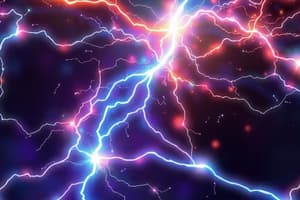Podcast
Questions and Answers
What defines an object as electrically neutral?
What defines an object as electrically neutral?
- Having only negative charge
- Having equal amounts of positive and negative charges (correct)
- Having only positive charge
- Having an unbalanced positive charge
What occurs when two objects with the same type of electric charge are brought near each other?
What occurs when two objects with the same type of electric charge are brought near each other?
- They repel each other (correct)
- They neutralize each other
- They attract each other
- They do not interact
What happens to the charge of a glass rod when it is rubbed with silk?
What happens to the charge of a glass rod when it is rubbed with silk?
- It gains negative charge
- It loses negative charge and becomes positively charged (correct)
- It gains positive charge
- It remains electrically neutral
How are materials classified based on their electrical charge movement?
How are materials classified based on their electrical charge movement?
What characterizes a charged object?
What characterizes a charged object?
When a plastic rod is rubbed with fur, what charge does it attain?
When a plastic rod is rubbed with fur, what charge does it attain?
What is the primary interaction between charged objects?
What is the primary interaction between charged objects?
Which of the following statements is true about electric charge?
Which of the following statements is true about electric charge?
What is the relationship between current density and electric field in materials where current density is proportional to the electric field?
What is the relationship between current density and electric field in materials where current density is proportional to the electric field?
Which expression correctly defines resistance in a conductor?
Which expression correctly defines resistance in a conductor?
If the potential difference across a wire is doubled while maintaining a constant length, what happens to the current according to Ohm's Law?
If the potential difference across a wire is doubled while maintaining a constant length, what happens to the current according to Ohm's Law?
What SI unit does resistance have?
What SI unit does resistance have?
What will increase the resistance of a conductor?
What will increase the resistance of a conductor?
When describing current density in a wire of uniform cross-sectional area A, what can current density (J) tell us?
When describing current density in a wire of uniform cross-sectional area A, what can current density (J) tell us?
What is the proper equation relating potential difference to the electric field and length of a wire?
What is the proper equation relating potential difference to the electric field and length of a wire?
What condition must be fulfilled for the current density equation J = σE to hold true?
What condition must be fulfilled for the current density equation J = σE to hold true?
What is the definition of electric current?
What is the definition of electric current?
What is the SI unit of electric current?
What is the SI unit of electric current?
Which of the following materials is considered a semiconductor?
Which of the following materials is considered a semiconductor?
How does the direction of conventional current relate to the flow of electrons in a conductor?
How does the direction of conventional current relate to the flow of electrons in a conductor?
What happens to the instantaneous current if the rate of charge flow varies over time?
What happens to the instantaneous current if the rate of charge flow varies over time?
Which statement about insulators is true?
Which statement about insulators is true?
Which formula represents the average current when a charge ΔQ passes through an area in time Δt?
Which formula represents the average current when a charge ΔQ passes through an area in time Δt?
What defines a superconductor?
What defines a superconductor?
Flashcards are hidden until you start studying
Study Notes
Electric Neutrality
- An object is electrically neutral when it contains an equal number of positive and negative charges.
Interaction of Like Charges
- When two objects with the same type of electric charge are brought near each other, they will repel each other.
Charging a Glass Rod
- When a glass rod is rubbed with silk, the glass rod loses electrons and becomes positively charged, while the silk gains electrons and becomes negatively charged.
Classifying Materials by Electrical Charge Movement
- Materials are classified as conductors, insulators, or semiconductors based on how easily electric charge can move through them.
Characteristics of a Charged Object
- A charged object has an imbalance of positive and negative charges.
Charging a Plastic Rod
- When a plastic rod is rubbed with fur, the plastic rod gains electrons and becomes negatively charged, while the fur loses electrons and becomes positively charged.
Interaction Between Charged Objects
- The primary interaction between charged objects is the electrostatic force, which can be attractive or repulsive depending on the charges of the objects.
Electric Charge Properties
- Electric charge is quantized, meaning it exists in discrete units.
- Electric charge is conserved, meaning the total charge in an isolated system remains constant.
Current Density and Electric Field Relationship
- In materials where current density is proportional to the electric field, the relationship is expressed as: J = σE, where J is the current density, E is the electric field, and σ is the conductivity of the material.
Defining Resistance
- Resistance (R) in a conductor is defined as the ratio of the potential difference (V) across the conductor to the current (I) flowing through it: R = V/I.
Doubling Potential Difference
- According to Ohm's Law, if the potential difference across a wire is doubled while maintaining a constant length, the current will also double.
Resistance Unit
- The SI unit of resistance is the ohm (Ω).
Factors Affecting Resistance
- Increasing the length of a conductor, reducing its cross-sectional area, or increasing its temperature will all increase its resistance.
Current Density Interpretation
- In a wire of uniform cross-sectional area A, current density (J) represents the amount of current per unit area. It tells us how concentrated the current flow is within the wire.
Potential Difference and Electric Field Equation
- The relationship between potential difference (V), electric field (E), and length of a wire (L) is expressed as: V = -EL.
Condition for Current Density Equation
- The current density equation J = σE holds true when the electric field is uniform and the material is homogeneous and isotropic.
Electric Current Definition
- Electric current is the flow of electric charge through a conductor.
Electric Current Unit
- The SI unit of electric current is the ampere (A).
Semiconductor Material
- Silicon is a widely used semiconductor material.
Conventional Current and Electron Flow
- Conventional current is defined as the flow of positive charge, which is opposite to the actual flow of electrons in a conductor.
Instantaneous Current Flow
- If the rate of charge flow varies over time, the instantaneous current will also vary accordingly.
Insulator Properties
- Insulators have a high resistance to the flow of electric charge.
Average Current Formula
- The average current (I) passing through an area in time Δt due to charge ΔQ is given by: I = ΔQ/Δt.
Superconductor Definition
- A superconductor is a material that exhibits zero resistance to the flow of electric charge below a critical temperature.
Studying That Suits You
Use AI to generate personalized quizzes and flashcards to suit your learning preferences.




